


Are you sure you want to reset the form?
Your mail has been sent successfully
Are you sure you want to remove the alert?
Your session is about to expire! You will be signed out in
Do you wish to stay signed in?
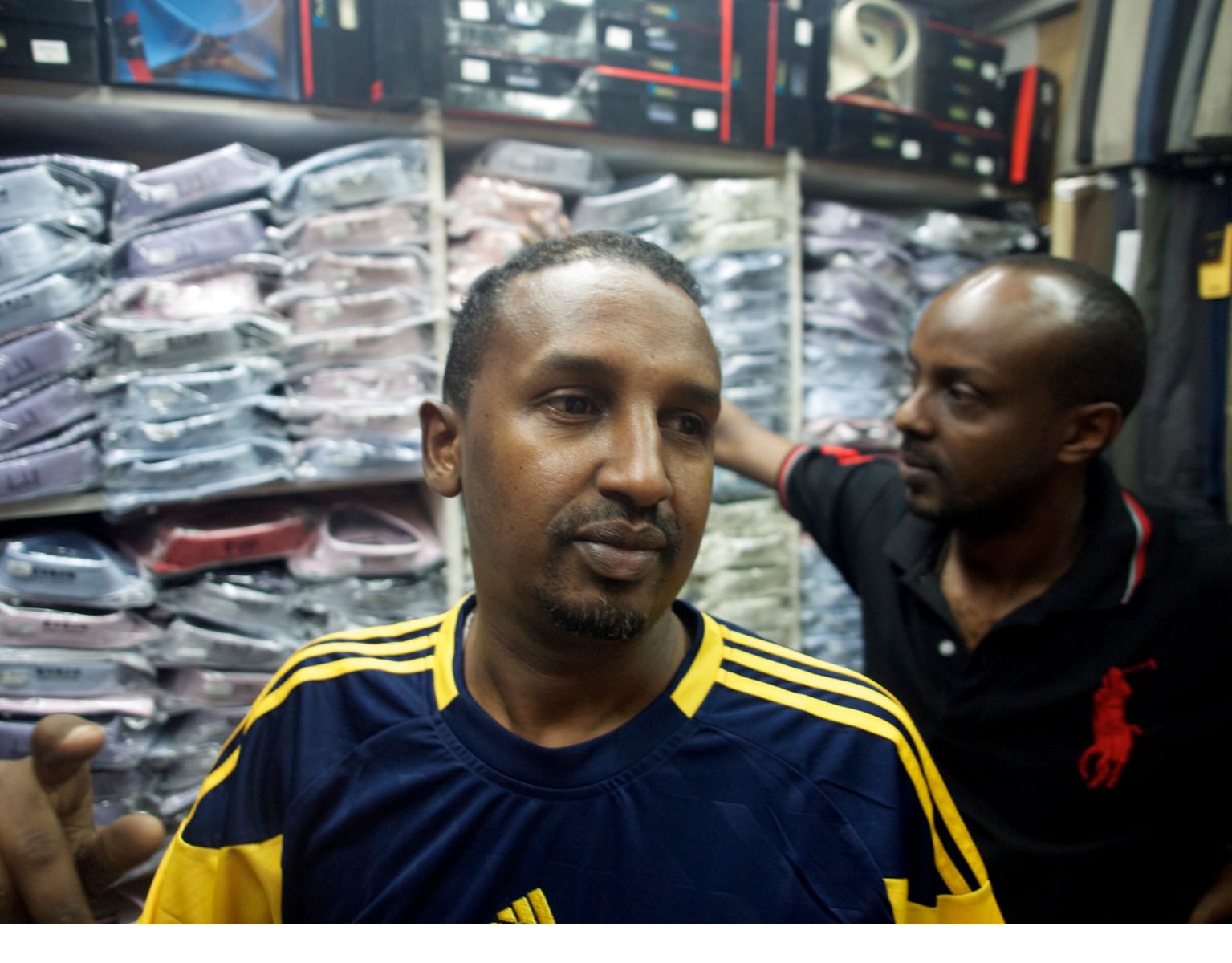
‘If you want to succeed in business, you need to earn trust’. So says Mohaa, a Kenyan Somali who runs a men’s fashions shop in Nairobi’s Eastleigh estate with his business partner Siad. His words echo sentiments commonly encountered in the estate. Mohaa moved to Eastleigh in 2005 searching for a better life, alongside many others. People see Eastleigh as a place of opportunity - because it has rapidly become a major East African commercial hub, globally connected to Somalia, the Gulf, Asia and the Somali diaspora living in Europe, North America, Australia and elsewhere. While host to a huge number of - mainly Somali and Ethiopian - urban refugees hoping to get resettled abroad, Eastleigh is also now seen as an attractive place for diaspora Somalis to invest in import/export businesses, hotels and restaurants. Somali identity that some call it ‘Little Mogadishu’, a name that rflects the great ambivalence with which Kenyans view the estate. While benefiting from its economy, many Kenyans see it as a foreign place almost as dangerous as the real Mogadishu, and link its growth to piracy in the Indian Ocean. In this photo essay we explore factors behind a transformation that really owes little or nothing to piracy. Our images show the people, activities and things that form the lifeblood of the estate and its economy. Commerce, huge capital investment, the management of credit and debt through relations of trust, and the hard work of the likes of Mohaa support this boom.
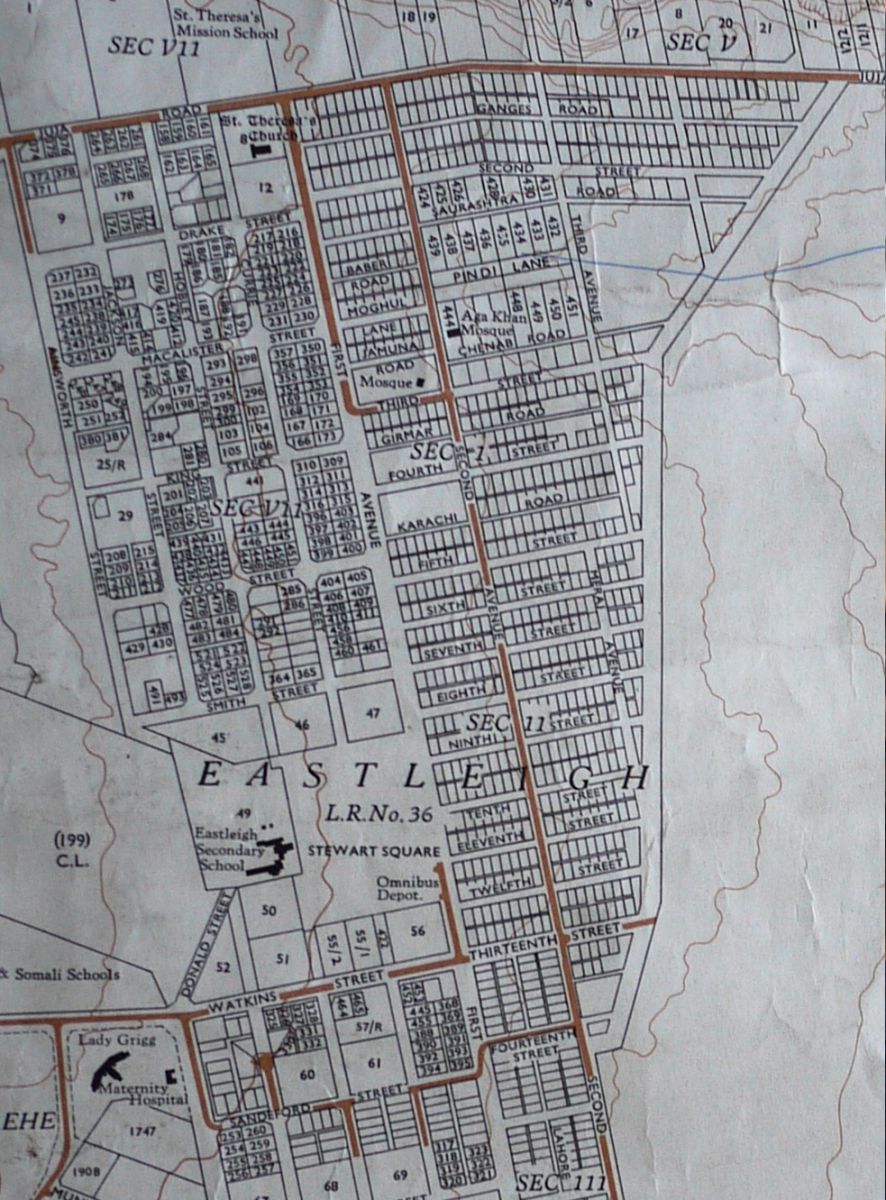
2: Changing Cityscape
Before 1991, Eastleigh was a very different estate. Early British and South African investors first became interested in the land early in the twentieth century, and no doubt were responsible for its very British name, but it was Indians and Somalis who bought up most of the plots. Few images survive of the earlier Eastleigh, but this map and its street names are suggestive of the Indian influence on the estate. The Indian population fluctuated, , while the Somali population kept constant over the years, and was especially dominated by Isaaq Somalis whose origins are in the northern area of the Somali region. Around the time of Independence most Asians left the estate for more upmarket suburbs, and Eastleigh underwent Africanisation. Non-Indians and Somalis began to settle there, having previously been restricted to ‘native’ areas such as Pumwani. Post-Independence, Eastleigh remained a lower middle-class residential area with a varied population of Kikuyu, some remaining Asians, Kenyan Somalis and others from the northern areas of the country. Eastleigh is in the Eastlands area of Nairobi, surrounded by ‘slum’ areas such as Mathare Valley, as well as the air base. It is only two kilometres from Nairobi city centre, a short ride on the ‘Number 9’ matatu route.
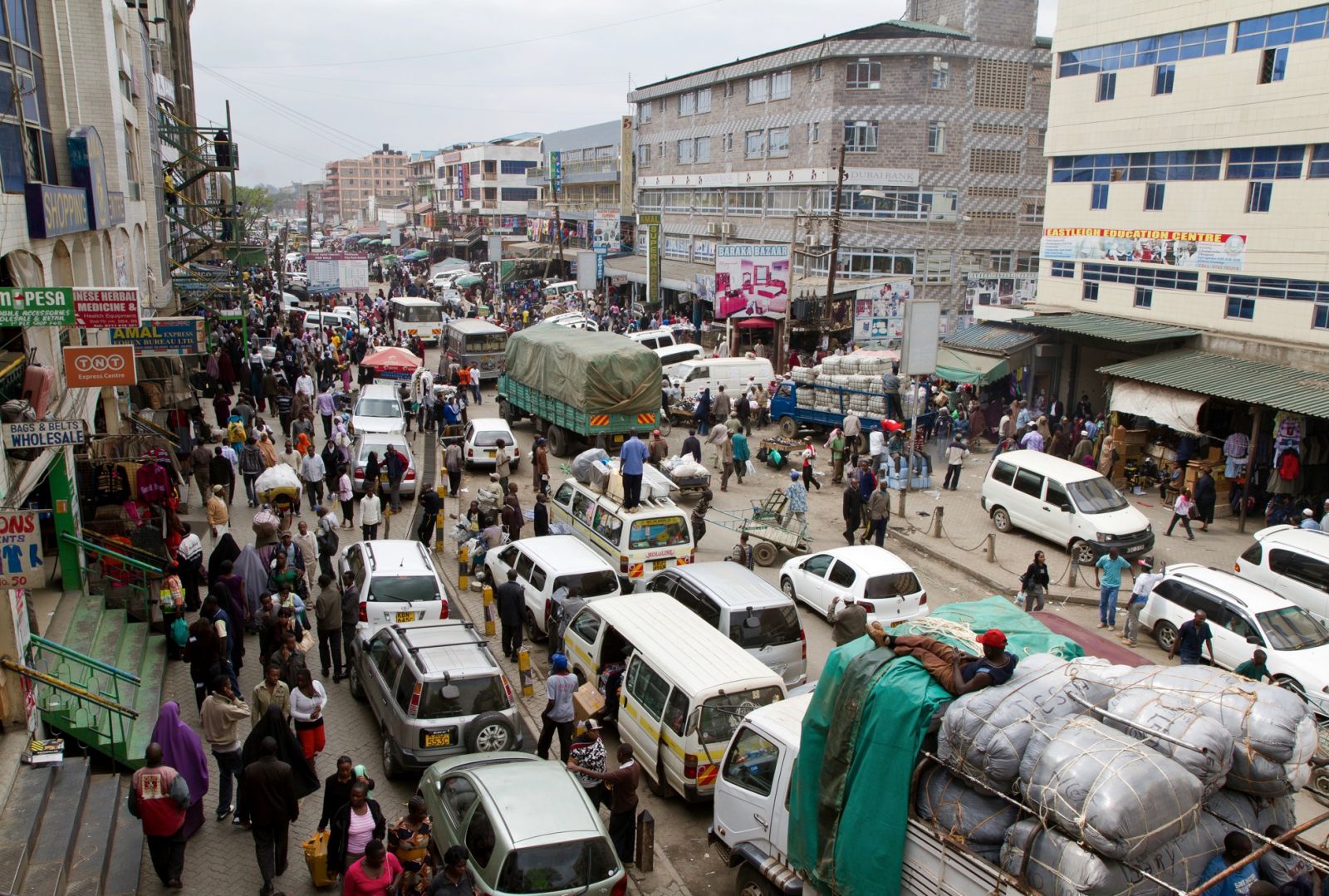
3: First Avenue
A far cry from its earlier incarnation as a quiet residential zone, this photograph speaks of a place transformed into an area of shopping malls and commerce. This is the view from the outside staircases of Amal Plaza, one of the largest malls in Eastleigh with over 500 shops. Mohaa reckons such a view allows you to tell how profitable your day as a trader will be. When the streets are crowded, chances are you’ll get lots of custom. Mohaa is philosophical about bad days, however: he quotes the Arabic phrase that there are always ‘yaum asal’ and ‘yaum basal’. ‘Honey days’ and ‘onion days’. The sheer scale of activity in this photograph is very suggestive of a ‘yaum asal’ in First Avenue, Eastleigh’s equivalent of Oxford Street. The trucks in the photograph are being loaded with bales of clothes and other textiles destined for Tanzania and even further afield.
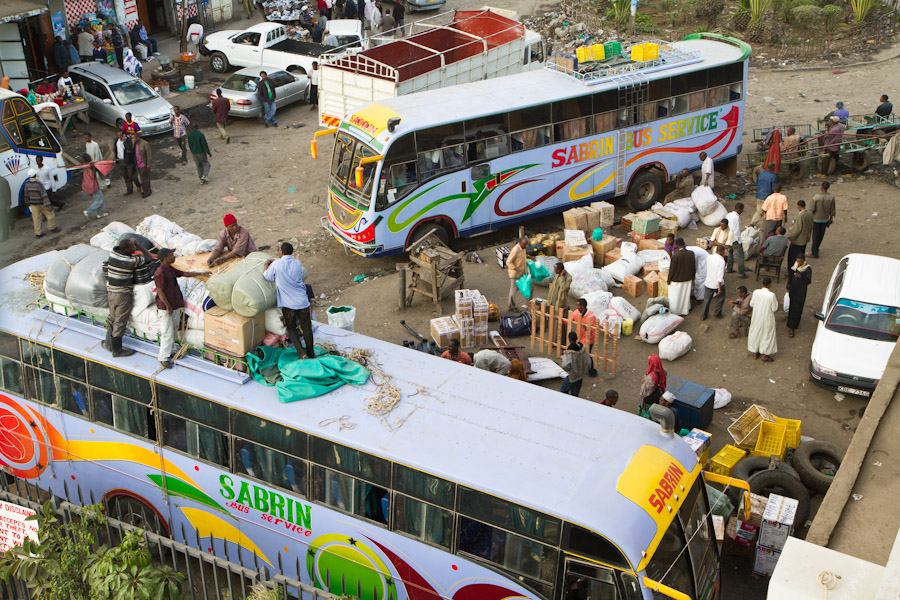
4. A Transport Hub for the North
Northern Kenya has a long history of marginalisation, with few paved roads serving a savannah-dominated region home to Somali, Borana, Gabra and other pastoralists, many of them Muslim. But Eastleigh is now connecting these people to the heart of Kenya, with bus routes serving the towns of Isiolo, Marsabit, Moyale, Garissa, Wajir, Mandera and other towns. Eastleigh’s urban refugee population often travel to and from the large refugee camps of Dadaab and Kakuma, and Eastleigh is a transport hub for these camps too. New refugees cross borders into Kenya in the north, and are then brought to Eastleigh via these transport connections. In the photograph we see buses being loaded prior to departure for Mandera, the Kenyan town at the intersection of the Ethiopia and Somali border, an important location for cross-border trade.

5. Starting Out
While Eastleigh is now known for its huge shopping malls, much of the trade in the estate is far more modest. A rags to riches narrative is quite common in Eastleigh, as refugees (Somali and Ethiopian), as well as Kenyan Somalis, start out with little but the ability to ‘hustle’, a popular term in the estate for the informal economic activity that many use to survive. Others begin their trade careers by hawking goods on the street. They can do this with little capital if wholesalers trust them sufficiently to advance them goods on credit. The next step might be to have a stall on the streets, like the ones shown in the picture. Some even say that such stalls can be more profitable than shops in the malls, as overheads are so much lower. A number of the women traders in this particular section of First Avenue used to have stalls in Mogadishu’s famous Bakaara Market, and accumulated a lot of business experience even before coming to Eastleigh
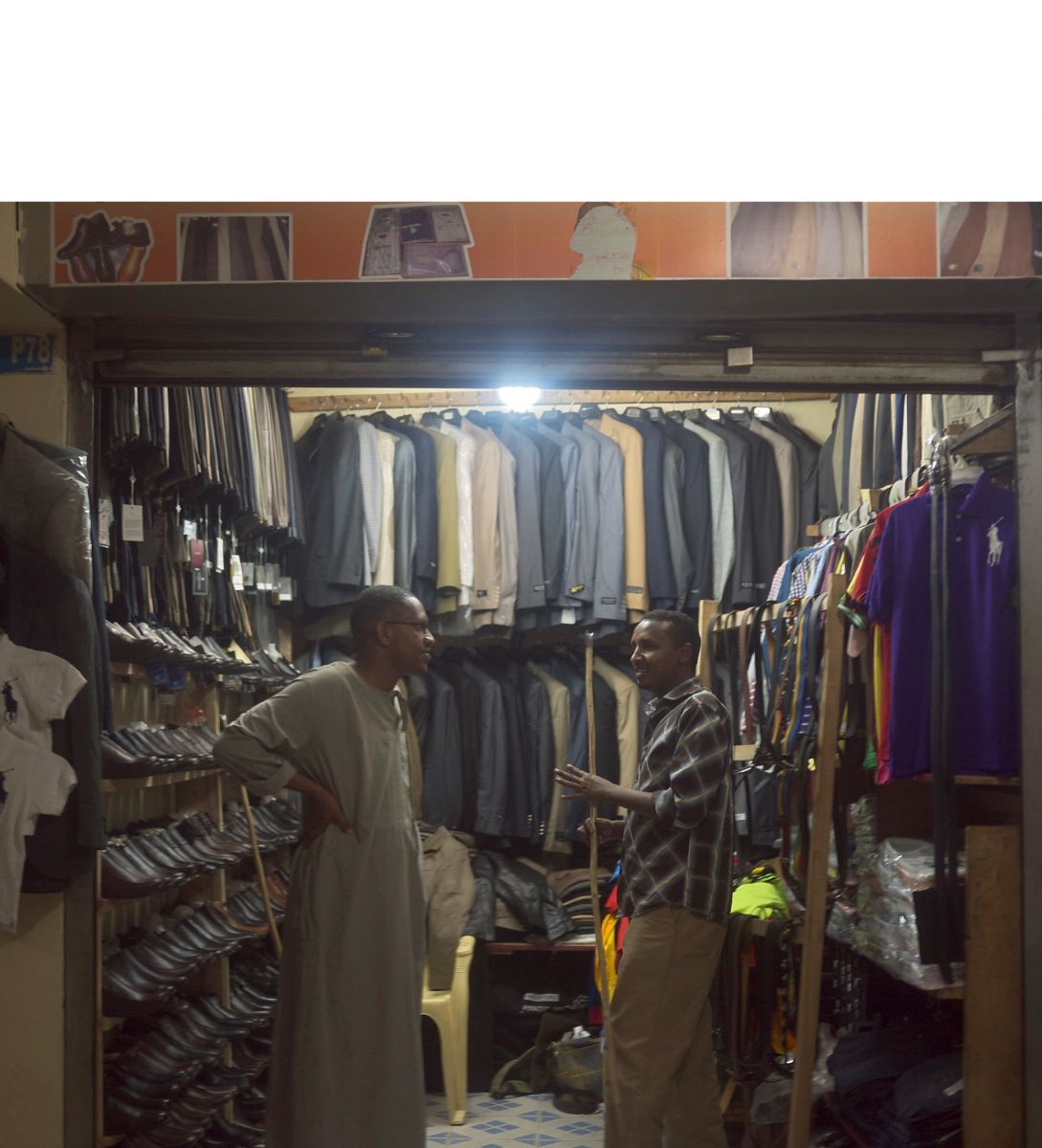
6. Shops
Graduating to a shop inside a mall is the next career step, usually a shop very much like Mohaa’s in this photograph. Mohaa himself started out working in the transport business in the northern Kenyan town of Isiolo, but found supporting his young family was difficult on meagre wages. He moved to Eastleigh in search of ‘greener pastures’ (a phrase popular among Somalis). He lived with friends and survived by ‘hustling’, often acting as a broker to attract customers for taxis and matatus (buses) in the estate. He soon moved up the ladder after earning the trust of a shop owner in one of the malls who took him on as a shopkeeper. There he met his future business partner Siad, and together they saved enough money to rent their own shops in Amal Plaza in 2008. Up until recently they had two shops, but now focus their efforts on Nasiib Fashions. They had been renting, but are currently saving up to buy the shop from its current owner, a Canadian Somali. While Mohaa’s story is typical of many traders in Eastleigh, others often rely on remittances from family in the diaspora. Much money sent from the diaspora in the West to refugee-inhabited places such as Eastleigh merely helps refugees survive; but other diaspora members are keen to make their relatives in Eastleigh self-sufficient, and one way to do it is to provide the $5000-10,000 required to set up a shop in the estate. Investment from the diaspora is a key factor in the success of the Eastleigh formula of large shopping malls filled with small shops.

7. Commodities
People sell electronics, household goods, furniture, gold and perfume in large quantities on the Eastleigh estate, but the quintessential commodities here are clothes and textiles, often Chinese copies of well-known brands including Britain’s own Marks and Spencer. Initially, clothes to Eastleigh were brought through a Somali-controlled network running from Dubai through Somalia, but after trade liberalisation in Kenya in the early 1990s, these networks switched to importing goods in huge volumes from Dubai through Mombasa port and Eldoret airport. Somali networks soon expanded to Asia, and by the mid 1990s Bangkok and Hong Kong had become key sources of goods. Now the main source of goods is China, and Somali cargo and clearing companies operate as far away as Guangzhou to facilitate this trade. These networks continue to evolve, as traders are always looking to exploit other sources, and goods also come to the estate through Kampala, Turkey and even London.
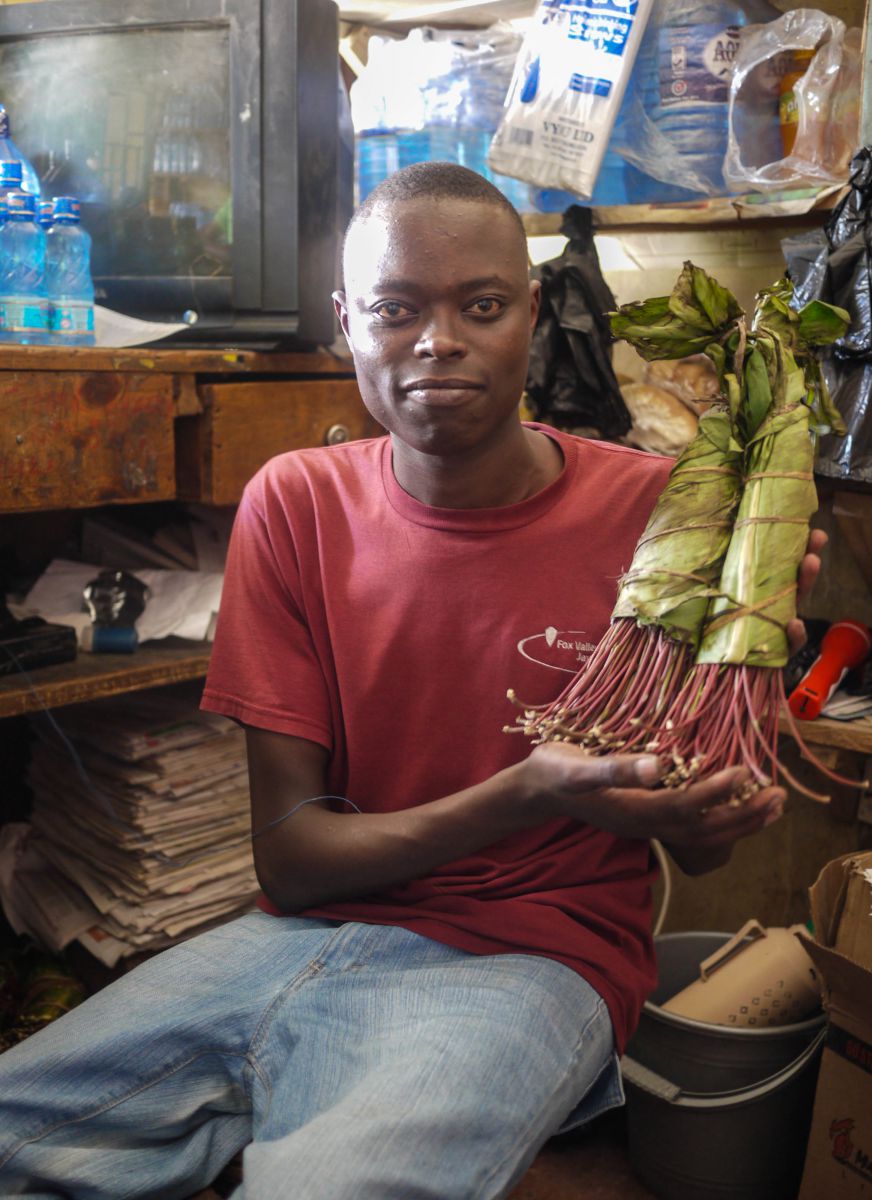
8. Miraa
It is not just goods of Asian provenance that are sold in the estate. Some are sourced much more locally. These include camel milk, which is very popular with Somalis, and is brought to the estate from towns such as Isiolo. A commodity associated with the estate in the minds of many Kenyans is the chewable stimulant miraa, or khat as it is more widely known. Eastleigh is a hub for selling khat to Europe and North America, and there have been fortunes made from its trade. The Meru people who produce the khat in their region northeast of Mount Kenya are present in the estate in large numbers, forming something of a sub-national diaspora community. In this photograph we see Mururu proudly holding two banana-leaf wrapped bundles of kangeta, a variety especially popular with Somalis in Eastleigh. Kangeta is expensive (around the equivalent of $10 for a bundle), but there are much cheaper varieties available in the estate, making it affordable for most strata of Eastleigh society. Certain parts of the estate become busy in the evening as men gather to chew khat, drink coffee, smoke shisha and indulge in conversation. It is a controversial substance, however, and disapproval ensures that there are many non-chewers in Eastleigh too. It is international exporters who make the most money out of khat. These exporters are usually Somalis with links to the diaspora abroad.
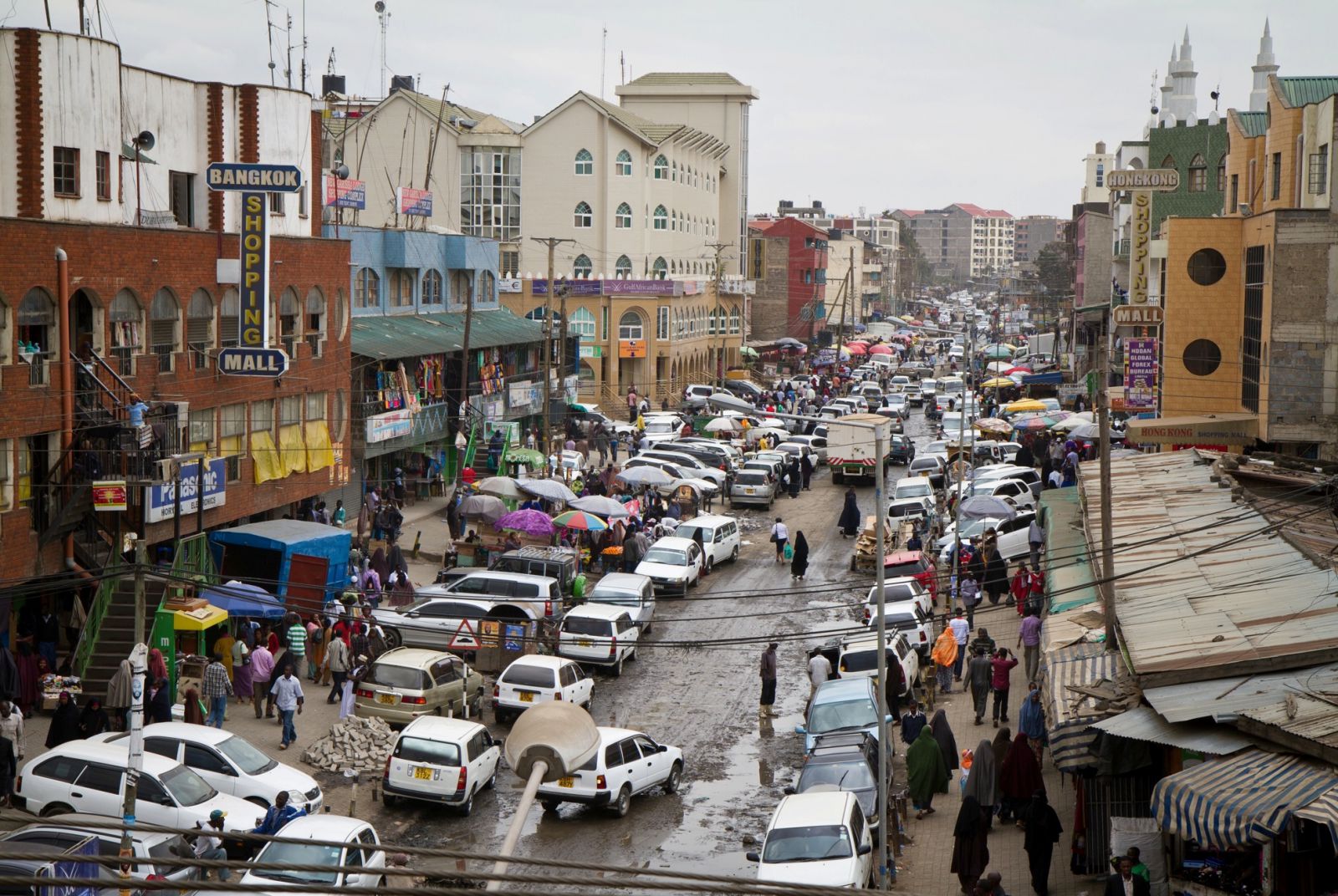
9. Garissa Lodge
All this commerce – including the trade in khat – has helped finance the huge malls seen in this picture of Eastleigh’s Jam Street. The original mall was Garissa Lodge, a lodging where many refugees stayed in the late 1980s. They had trading experience and rather than remaining idle, they tapped into pre-existing trade networks running from Dubai through Somalia that once made Kenyan towns like Isiolo key shopping destinations for the textile industry. These refugees made Eastleigh the focal point of these networks in Kenya, trading in a very informal way: they would sell clothes on their beds during the day, then sleep on them at night. The building was eventually converted from a lodging to a shopping mall in the early 1990s. Other malls were soon built, especially in the wake of trade liberalisation which allowed for the import of larger quantities of goods through Somali transnational networks. Such malls have been built by business groups who purchase the land and raise capital for construction in advance by soliciting ‘goodwill’ payments from would-be shopkeepers. In Kenya, the term ‘goodwill’ refers to payments made to reserve the rights to trade in a shop. This does not mean outright ownership of a shop, as rent will still have to be paid. In Eastleigh such payments can be as high as $20,000 to reserve a shop in a good location. At the height of the Eastleigh boom, this method worked well, such was the demand for shops, but now it is said to be harder to get people to reserve all the shops in this way, and some more recent malls do not charge goodwill.

10. Construction
The Eastleigh landscape has transformed in the wake of this commercial boom, with so many malls being built, as well as hotels, restaurants and banks, and the construction shows no sign of slowing. Here a new hotel is being built. It is already nearing completion and stands proudly next to the Grand Royal Hotel, one of the most luxurious examples of the hotel industry. The Grand Royal Hotel developed on the back of the commercial boom, providing a base for wealthy Somalis from the diaspora, and from Somalia itself, who travel to Eastleigh for business and leisure. Indeed, the foyer of the Grand Royal is given a cosmopolitan soundscape, as East African, British, Scandinavian and North American accents all mix together. Some Somalis reckon that in the future, clan might be less important in marking sub-ethnic social groups, and that instead of describing Somalis as Hawiye or Isaaq, people will speak more of British and American Somalis.
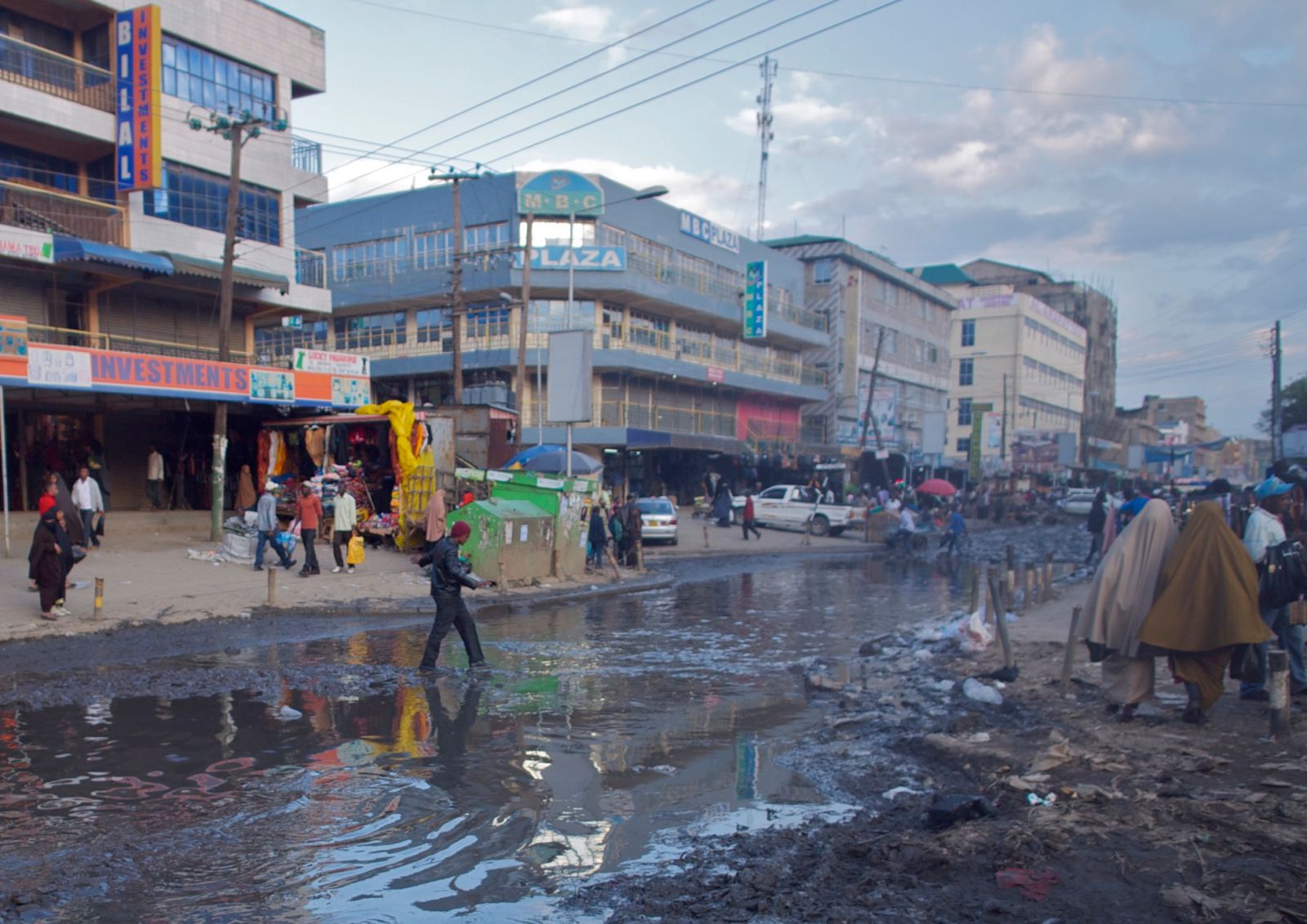
11: Decaying Infrastructure
This frenzied construction of malls and hotels stands in marked contrast to the estate’s infrastructure, which has decayed in tandem with the boom. The sewage system was built to cope with a small residential population, not a major commercial hub. Balancing precariously on stepping stones while crossing roads flooded with sewage is one of Eastleigh’s challenges. Infrastructural decay is a key complaint among Eastleigh’s residents and businesspeople. They observe that they bring much to the Nairobi and wider Kenyan economy – the estate is reckoned to be in the top three revenue sources in Nairobi and its trade gives employment to many Kenyans – but that the state does little in return to improve life in Eastleigh.
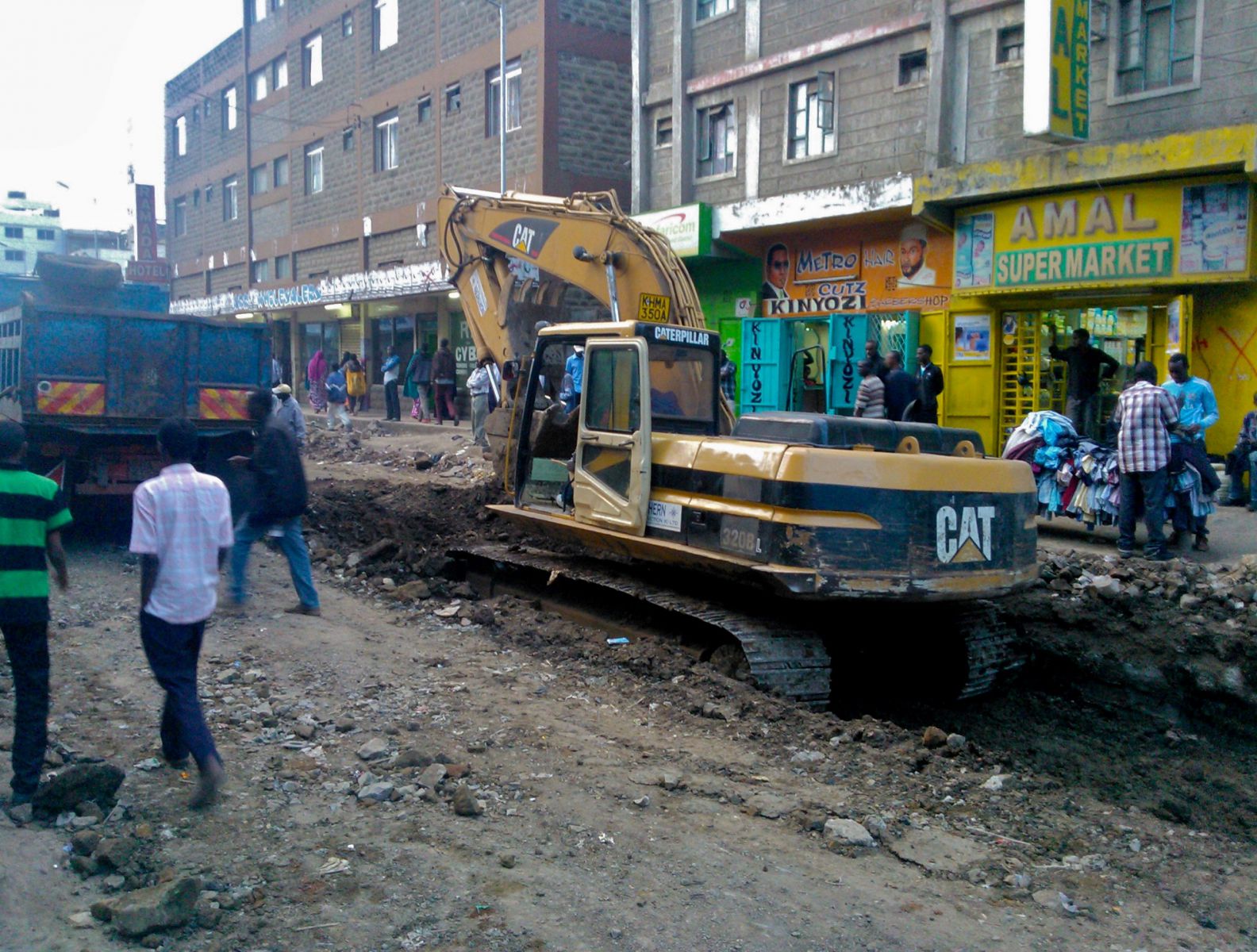
12. But even this might be changing…
This lack of infrastructure improvement has been symbolic of the state’s neglect of Eastleigh, made worse by suspicion of its economic boom and of the many Somalis and other refugees resident there. Things might be changing, however: with contracts to repair roads in place and work started on 2nd Avenue (a road in appalling condition), the new Kenyan Somali MP for Kamukunji where Eastleigh is situated is said to have made a real difference. He lobbies for such repairs, while also improving street lights and helping reduce police harassment of refugees. Eastleigh is also said to feature centrally as a commercial hub in ‘Vision 2030’, the Kenyan government’s strategy for the country’s development. It seems that the government is becoming more appreciative of the economic impact of the estate and its transnational linkages.
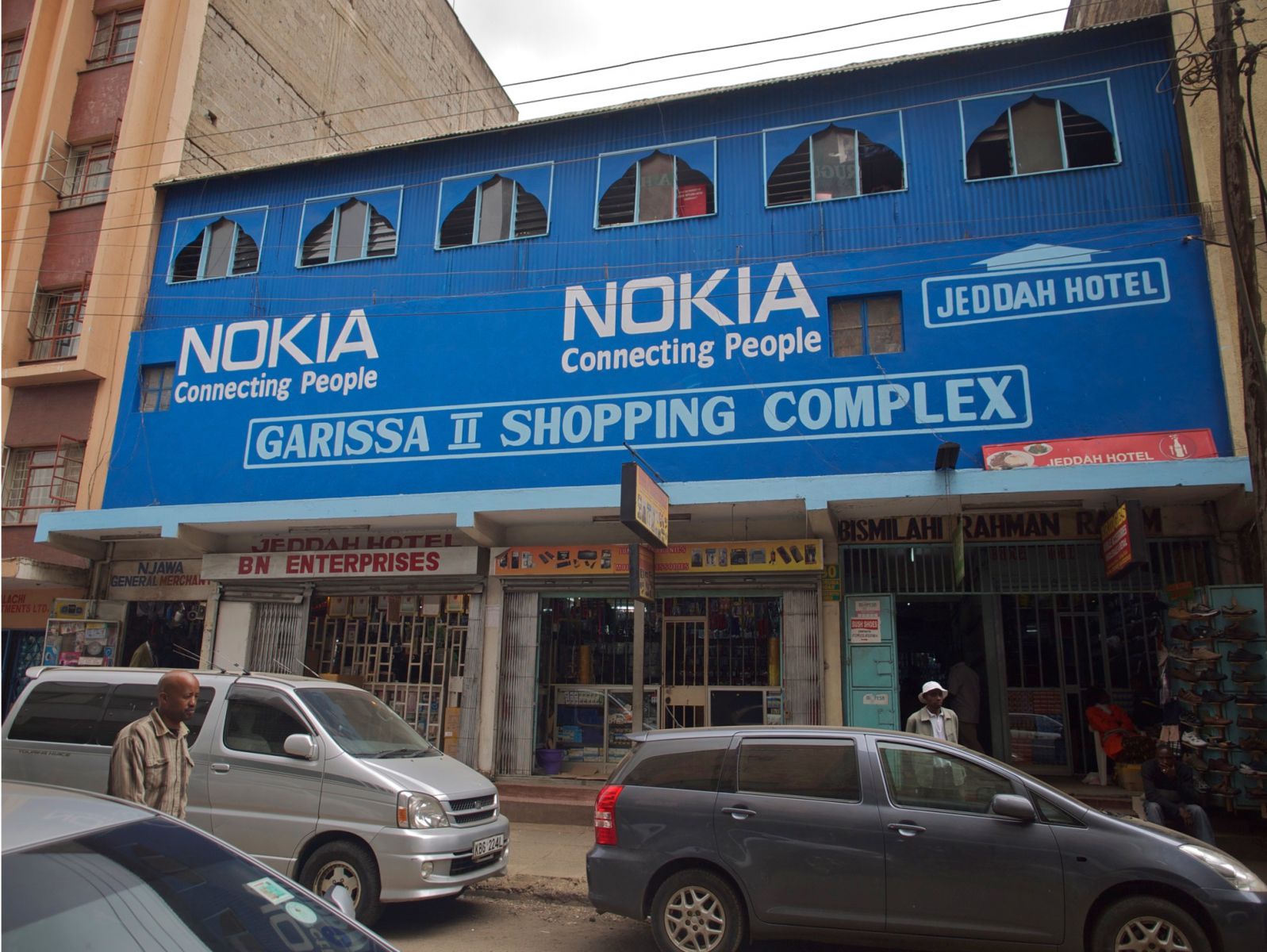
13. The model has spread
The shopping malls of Eastleigh are now models for similar malls throughout the country, including ‘Garissa II’, a shopping mall in central Nairobi. Such malls – mainly operated by Somalis – can also be found in Kisumu and Mombasa, while stalls and hawkers selling goods sourced in Eastleigh are everywhere in Kenya.

14. Entrepreneurship
While commerce in basic commodities is the lifeblood of the estate, entrepreneurship has expanded in many other directions thanks to the foundation pictured here. Burhan – to the left of this photo taken in Nairobi city centre – is representative of such entrepreneurship, having worked in a Forex bureau, established a cyber café, founded an advertising agency for Eastleigh businesses, and inaugurated a magazine featuring stories of interest to the Somali diaspora. He is now working on a project entitled ‘Eastleighwood’, a media production and ‘youth empowerment’ initiative.

15. Eastleighwood
With Eastleighwood, Burhan has moved from entrepreneur to impresario, promoting the musical talent that exists among Somali youth in Eastleigh. This talent is now frequently showcased on Somali cable TV channels, uploaded onto Youtube and Facebook, and digested by Somalis throughout the world. Eastleigh is not just a place of business. It is where Somalis come from all parts of the world, and so a place where Somali entertainment is desired. Music – Somali, Kenyan and Ethiopian – can be heard everywhere on the streets. It is played live at weddings held in Eastleigh’s plusher hotels, and even at miraa chewing sessions. While Eastleigh is enriched by many other influences, Somali culture naturally predominates, as other Somali aspects of life have grown upon the economic foundations of the estate.

16: Islam
The changing face of Eastleigh also owes much to religion, especially Islam, and here we see an Islamic scholar addressing the audience at an Eastleighwood event. Of course, there have been mosques in Eastleigh almost since its inception, though the old Aga Khan mosque is now a bakery. Islam is reckoned by many in Eastleigh to be at the heart of the relations of trust that glue its economy together. The shopping mall and the mosque go together – the bigger malls all have a mosque on their top floor where traders can pray. While much miraa-chewing occurs in the estate – meeting disapproval from the more religious – prayer is another key activity, and the likes of Mohaa all avail themselves of the mosques provided by the malls at prayer times. There is some evidence, however, that the estate is becoming more religious, leading to some disapproval of aspects of the estate’s economy. Indeed, raising capital through the miraa trade and goodwill payments is now regarded as haram (sinful) by the more religious. While earlier malls were named after Kenyan towns or the places of origin of the many commodities sold in the estate, new names for malls include Madina and Mecca. Islam is becoming more central to business in the estate as new property development companies are headed by Imams, so attracting yet more investment to the estate from diaspora Somalis willing to trust such religious dignitaries with their money.
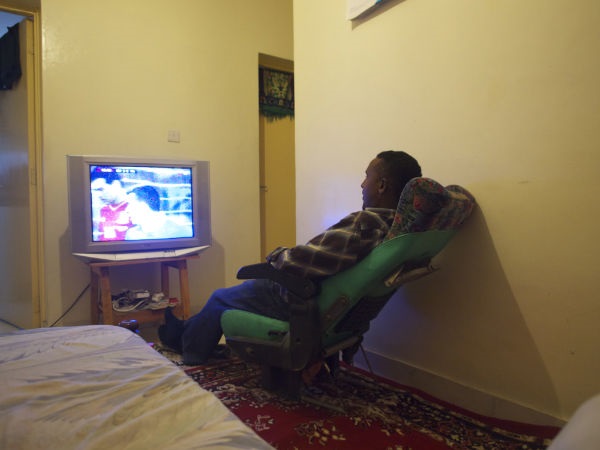
17. Good Fortune
Mohaa works hard to develop his clothing business, and it is not surprising that he likes to relax at home in the evening – here we see him enjoying some down time in one of the bus seats that adorn his sitting room. These seats prove ideal for watching football, and perfect for Mohaa, someone who started out in the transport industry. Mohaa is not yet content with his life, especially as his family are not with him but still live in Isiolo. While he sees them regularly, he would like to be with them all the time. However, he knows that his decision to leave Isiolo and engage with the diaspora-fuelled economic boom of Eastleigh has been economically beneficial. While he emphasises that building up trusting relations with suppliers and customers has been key to his business, along with hard work, there has been much luck too. Indeed, the name of his shop hints at this – Nasiib meaning ‘good fortune’ in Somali.

.